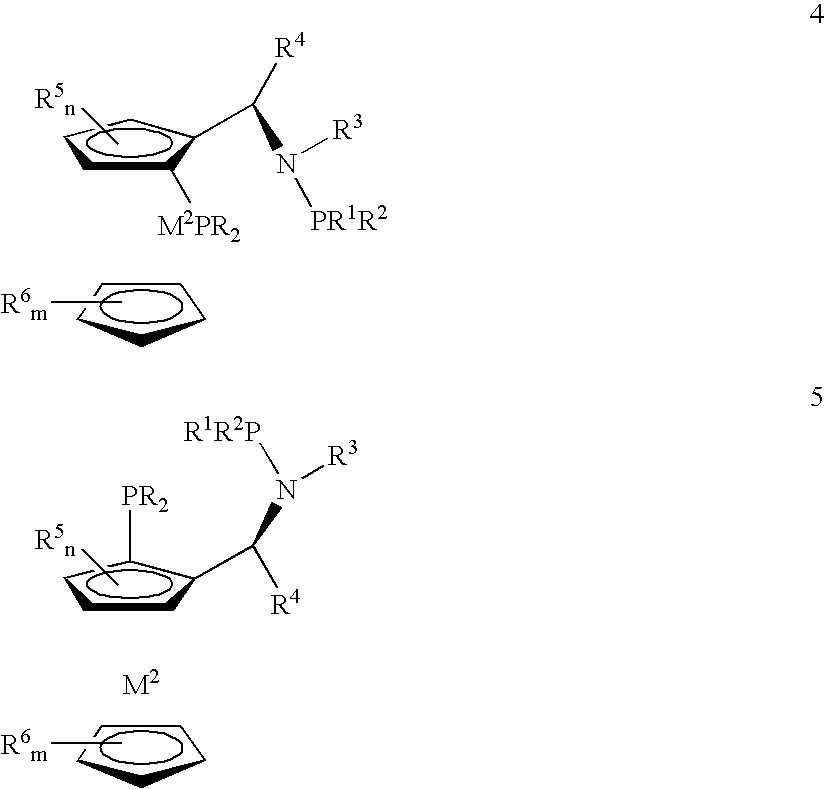Preparation of aminophosphines
a technology of phosphine and aminophosphine, which is applied in the field of preparation of aminophosphine, can solve the problems of difficult and therefore expensive production of ligands, difficult method, and difficulty in preparing disubstituted phosphine halide,
- Summary
- Abstract
- Description
- Claims
- Application Information
AI Technical Summary
Benefits of technology
Problems solved by technology
Method used
Image
Examples
example 1
Preparation of (R)-N-diphenylphosphino-N-methyl-1-[(S)-2-(diphenylphosphino)ferrocenyl]ethylamine (4a)
[0034]Toluene (10 mL) was added to a 100mL 3-necked flask which was cooled in ice to below 5° C. Phosphorus trichloride (0.26 mL; 3.0 mmol; 1.0 equiv based on 2a) was added followed by triethylamine (0.50 mL; 3.6 mmol; 1.2 equiv). (R)-N-methyl-1-[(S)-2-(diphenylphosphino)ferrocenyl]ethylamine (2a)(1.26 g; 3.0 mmol) dissolved in 10 mL of toluene was added over about 5 minutes such that the temperature remained below 10° C. The reaction mixture was allowed to warm to ambient temperature over 30 min and stirred at ambient temperature for 2 hours. The reaction mixture was cooled in ice to below 5° C. and a 3.0 M solution of phenylmagnesium bromide in diethyl ether (3.5 mL; 10.5 mmol; 3.5 equiv) was added over approximately 10 minutes such that the temperature remained below 10° C. The reaction mixture was allowed to warm to ambient temperature overnight to completely consume 2a accordin...
example 2
Preparation of (R)-N-diphenylphosphino-N-isopropyl-1-[(S)-2-(diphenylphosphino)ferrocenyl]ethylamine (4b)
[0036]Toluene (10 mL) was added to a 100-mL 3-necked flask which was cooled to below −70° C. in a dry ice-acetone bath. Phosphorus trichloride (174 μL; 2.0 mmol; 1.0 equiv based on 2b) was added followed by triethylamine (0.33 mL; 2.4 mmol; 1.2 equiv). (R)-N-Isopropyl-1-[(S)-2-(diphenylphosphino)ferrocenyl]ethylamine (2b)(910 mg; 2.0 mmol) dissolved in 8 mL of toluene was added dropwise such that the temperature remained below −50° C. The reaction mixture was stirred in dry ice-acetone for 1 hour, then allowed to warm to ambient temperature over 1 hour and stirred at ambient temperature for 2 hours. The reaction mixture was cooled to below −70° C. and a 3.0 M solution of phenylmagnesium bromide in diethyl ether (2.33 mL; 7.0 mmol; 3.5 equiv) was added such that the temperature remained below −50° C. The reaction mixture was allowed to warm to ambient temperature overnight to comp...
example 3
Preparation of (R)-N-diphenylphosphino-N-neopentyl-1-[(S)-2-(diphenylphosphino)ferrocenyl]ethylamine (4c)
[0038]Toluene (10 mL) was added to a 100-mL 3-necked flask which was cooled to below −70° C. in a dry ice-acetone bath. Phosphorus trichloride (174 μL; 2.0 mmol; 1.0 equiv based on 2c) was added followed by triethylamine (0.33 mL; 2.4 mmol; 1.2 equiv). (R)-N-Neopentyl-1-[(S)-2-(diphenylphosphino)ferrocenyl]ethylamine (2c)(967 mg; 2.0 mmol) dissolved in 8 mL of toluene was added dropwise such that the temperature remained below −50° C. The reaction mixture was stirred in dry ice-acetone for 1 hour, then allowed to warm to ambient temperature over 1 hour and stirred at ambient temperature for 2 hours. The reaction mixture was cooled to below −70° C. and a 3.0 M solution of phenylmagnesium bromide in diethyl ether (2.33 mL; 7.0 mmol; 3.5 equiv) was added such that the temperature remained below −50° C. The reaction mixture was allowed to warm to ambient temperature overnight to comp...
PUM
| Property | Measurement | Unit |
|---|---|---|
| boiling point | aaaaa | aaaaa |
| temperature | aaaaa | aaaaa |
| temperature | aaaaa | aaaaa |
Abstract
Description
Claims
Application Information
 Login to View More
Login to View More - R&D
- Intellectual Property
- Life Sciences
- Materials
- Tech Scout
- Unparalleled Data Quality
- Higher Quality Content
- 60% Fewer Hallucinations
Browse by: Latest US Patents, China's latest patents, Technical Efficacy Thesaurus, Application Domain, Technology Topic, Popular Technical Reports.
© 2025 PatSnap. All rights reserved.Legal|Privacy policy|Modern Slavery Act Transparency Statement|Sitemap|About US| Contact US: help@patsnap.com



